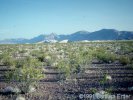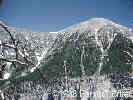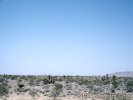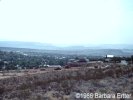 Carl Purpus, Plant
Collector in Western America
Carl Purpus, Plant
Collector in Western America 
C. A. Purpus Translated from German by
Barbara Ertter
 




|
Original Title: Eine Succulententour Von C. A. Purpus, San Diego (Kalifornien). Monatsschrift fur Kakteenkunde. 9(4): 49-52; 65-68.
|  Dunes in
Amargosa Desert, Nevada. Dunes in
Amargosa Desert, Nevada.  Beatty, Nevada, at the south end of Oasis Valley. Beatty, Nevada, at the south end of Oasis Valley.
Locations: Amargosa Desert. Amargosa River. Oasis Valley.
Late in the evening we reached Oasis Valley. Here were found the springs of the Amargosa River that disappear into the sand after a brief existence. The river consists of one such dried bed that traverses the Amargosa Desert and wends its way to Death Valley. The following day we reached the Amargosa Desert, a totally waterless undulating plain forty miles long. It is flanked to the right
by the Grapevine Mountains and to the left by the notorious Funeral Mountains, an extremely dry range that is nearly devoid of springs.
|
|  Spring in Ash Meadows, Nevada.
Spring in Ash Meadows, Nevada.
Locations: Ash Meadows. We continued onward to Ash Meadows,
a wide meadow valley distinguished by the innumerable warm springs that surface here. At the foot of the mountains surrounding the valley, I encountered Echinocactus polycephalus for the first time in some while. Cereus engelmannii and the usual desert Opuntia species also occurred here.
|
|  Pahrump, Nevada, with Spring Mountains in the background.
Pahrump, Nevada, with Spring Mountains in the background.
Locations: Pahrump Valley. After a two-day rest,
our journey continued toward Pahrump Valley, which lay at the base of the Charleston Mountains, whose highest point, Charleston Peak, was still partly covered with snow. On limestone outcrops I found an almost completely white-spined specimen of Mammillaria tetrancistra Engelm. (M. phellosperma).
|
|  Outcrop in Spring Mountains, Nevada.
Outcrop in Spring Mountains, Nevada.
Locations: Charleston Mountains. The
following morning I departed early in the morning in order to explore the botanically fascinating Charleston Mountains. At about 1000 m there appeared a Yucca with thick fleshy leaves and a short, thick stem some 1.2-2 m tall. I took it at first to be Yucca baccata Torr., but it later proved to be Yucca macrocarpa Torr. In very stony ground in the washes I also found the incomparably beautiful Mammillaria deserti Engelm., with its red-gold flowers and silvery brown-tipped spines that almost completely enshroud it. Whereas at first only isolated specimens were to be found, it was more abundant at higher elevations.
|
|  Charleston Peak, Spring Mountains, Nevada.
Charleston Peak, Spring Mountains, Nevada.
Locations: Charleston Peak. At about 1300 m I
found Yucca arborescens growing with Yucca macrocarpa. This was gradually replaced by the trunkless Yucca baccata Torr., which ascended to over 2000 m. It was covered with large, white, bell-shaped flowers and made a splendid display. Upon reaching the Pinus monophylla zone, I found another Mammillaria covered with with gorgeous, large, deep red flowers growing in the shade of the pines. It was later described by Brandegee as Mammillaria radiosa Engelm. var arizonica. Representatives of Opuntia I noticed in the area were O. chlorotica Engelm. & Big. and a single specimen of O. palmeri Engelm. that until now had only been known from Utah and northern Arizona. We made camp for several days at a half-dried spring. The next day I attempted an ascent of Charleston Peak; however, I did not reach the summit.
|
|  Indian Springs, Nevada.
Indian Springs, Nevada. Locations: Indian Spring Valley. On one of the next days we departed
for Indian Spring Valley. On the way there I found Opuntia tessellata Engelm., O. parryi Engel., Cereus engelmannii, and occasional specimens of Mammillaria deserti growing on the eastern slopes of the Charleston Mountains. Indian Spring Valley is a desert bordered to the east by the Desert Range and its southern continuation, the Sheep Mountains. A powerful spring arising in the center of the valley transforms this part into an oasis. It is named for the ranch where we rested for several days.
|
| The next day I
explored the rocky hills at the base of the Charleston Mountains. On the stony slopes I found a splendid Echinocactus three feet high. I took it to be E. wislizenii Engelm. var. lecontei Engelm. at first, but according to Brandegee it is not that but instead a closely related species. The curved thorns were a lovely golden or reddish color, and young specimens were absolutely charming. Echinocactus polycephalus and Cereus engelmannii could also
be found here.
|
| Locations: Sheep Mountains.
Unwillingly I forsook the shade of the poplars that hemmed the ranch and proceeded through the desert under the sun's full heat. Toward evening we arrived at the foot of the Sheep Mountains, which I explored on the following day. The Sheep Mountains are a highly interesting rocky range, furrowed with deep canyons and flanked by steep cliffs on which grew magnificent specimens of
the aforementioned Echinocactus. In addition, I saw here for the first time the
lovely Agave utahensis Engelm. with it long, golden inflorescence that contrasted
so beautifully with the dark limestone.
|
|  Las Vegas, Nevada.
Las Vegas, Nevada.  Desert near Las Vegas, Nevada.
Desert near Las Vegas, Nevada.
Locations: Las Vegas Valley. Muddy Creek. Vegas Desert.
From here we travelled through the Las Vegas Valley with its abundance of
springs. After several days' sojourn, we continued through the Vegas Desert, a completely waterless wasteland of considerable extent, toward Muddy Creek, which
we reached after two days of travel. On the rocks of the hills that traverse this land I found an Echinocactus that resembled those already discussed, except it was about a foot taller and covered with short, curved spines. Muddy Creek flows through a beautiful meadow valley bordered by dry hills and mountain ranges. Although it connects with the Virgin River below St. Thomas, the water usually sinks into the sand before it actually reaches the river.
|
|  Virgin Range and river valley near Bunkerville, Nevada.
Virgin Range and river valley near Bunkerville, Nevada.
Locations: Saint Thomas. Virgin River. Virgin Range.
We arrived at St. Thomas after travelling for several more days through the blazing hot climate. We rested for a day and then continued on our way to the Virgin River, whose muddy reddish waters flowed in their broad bed between high bluffs. We followed the river upstream and reached the border of Arizona after several days' travel, stopping at the foot of the Virgin Range. On the rocky bluffs that hemmed the shore I noticed beautiful specimens of Echinocactus wislizenii Engelm. var. lecontei Engelm. growing four feet or more all, as well as E. polycephalus. I decided to explore the mountain, and set out to do so early the following day. After hiking for two hours over a rocky plain traversed by dry streambeds, I reached the slope of the mountain. Upon my ascent of the slopes, I found the lovely Opuntia palmeri along with Echinocactus wislizenii Engelm. var. lecontei. Large quantities of Yucca baccata covered the rocky slopes in the Pinus monophylla zone.
|
|
Locations: Beaver Dam Mountains.
The following day we proceeded further upriver to the Beaverdam Mountains, which at this point were in Utah. The slopes were covered with Yucca arborescens on the lower parts and Yucca baccata on the upper. Beautiful specimens of the enchanting Echinocactus johnsoni Engelm. appeared at about 1000 m on exceedingly stony ground of limestone and shale, at first individually, then more frequently at higher elevations. Intermixed there grew a very lovely, large jointed Opuntia that was completely covered with short, brownish gray spines, in addition to O. basilaria and Cereus engelmannii. The Cereus was extraordinarily variable in
spine color and length. We made camp under steep limestone cliffs on the south side of which grew an abundance of Echinocactus johnsonii. Its spines varied greatly in color, sometimes golden red, sometimes deep red, and sometimes even approaching violet. Great numbers of Agave utahensis, still in bloom, also grew on the cliffs, as did Echinocactus wislizeni Engelm. var lecontei Engelm. and Cereus engelmannii.
|
| Our route now led
uphill into the mountains. In the partial shade of Pinus monophylla I saw Mammillaris radiosa Engelm. var arizonica. On the side of the mountain I found Opuntia acanthocarpa Engelm., which is very similar to O. echinocarpa and, like it, is covered with abominable spines.
|
|  St. George, Utah.
St. George, Utah.  Red sandstone north of Saint George, Utah.
Red sandstone north of Saint George, Utah.
Locations: Pine Valley Mountains. Santa Clara Creek. Saint George. After travelling several more days
we reached our destination, St. George in Utah, an interesting fertile region, on a hot July day. Noteworthy here were the deep red cliffs bordering the shores of Santa Clara Creek that so often resemble the ruins of old castles. Above these remarkable labyrinthine cliffs
rose the Pine Valley Mountains, which drop steeply to the west and look like a single gigantic rock wall.
|
| From St. George,
where I only stayed a short while because of the heat, I began my return trip to California through the heart of Nevada.
| |
[Previous Page] | Go to page: [1] [2]
|
| [Published Biographies] [Travelogues and Articles] [Letters] [Plant Lists and Bibliography] [Site Administration] | | Date and time this article was prepared: 6/7/2002 7:32:22 PM |